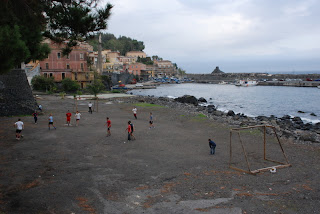




After saying goodbye to the English family, we left the most comfortable, prettiest and cleanest site that we have stayed at in Sicily and probably in the whole of Italy. Definitely one to visit again in we are in the area.
Punta Braccetto is an oasis in a sea of plastic. The area produces a huge amount of vegetables and specialises in tomatoes and particularly cherry tomatoes. Next time that you buy out-of-season cherry tomatoes in your local supermarket, they may have come from here. Our route took us close to the sea all of the way to Gela and up to Lake Biviere we must have past thousands of acres of plastic greenhouses most with tomatoes in various phases from seedlings to productive plants. From the lake onwards, vines and olive trees replaced the plastic until we arrived at the ugly industrial side of Gela with many refineries and chemical plants.
The first part of the road heading inland from Gela towards Piazza Armerina was marked as 'picturesque' on the Michelin map but we felt that it became much more picturesque almost from the moment that the green line ran out on the map. We had been climbing gently since leaving the coast and the mountain scenery was very pleasant. A different type of agriculture dominated here, one that I had never seen before – cacti groves. We had seen prickly pears (the fruit of the cactus) for sale in the markets at a very reasonable €2 per kilogram. At least it seems a reasonable price compared to other fruit and vegetables but I have never tasted one and have no idea of how they are prepared or cooked, if indeed they are not eaten raw (without the spikes I presume). Another thing to look up on the Internet.
And then I saw it – Etna. Without clouds and capped with snow it looked magnificent. I'm happy now!
We travelled to Piazza Armerina for one reason, the Villa Roman di Casale, 4 km outside the town. The 4th century AD villa is thought to be a hunting lodge of Roman Emperor Maximianus Heraclius. Amazingly it was in use up to the 12th century when it was covered in a mudslide. These two facts explain the preservation of the 12,000 square feet (no, that is not a misprint) of beautiful, high quality mosaics. As you can see from the photographs above, they really are fantastic. There is a huge amount of work going on at the site at the moment as walls are consolidated, mosaics repaired and new visitor walkways installed. This meant that substantial parts of the villa, especially the baths were closed off and parts of other mosaics were covered. The entrance fee was reduced to €3 and we were concerned that there would be little to see but this was not the case and it was well worth the visit. Hunting scenes and exotic animals were everywhere – lions, tigers, leopards, camels and many more; a huge scene showed a Roman circus (an oblong race track) with a chariot race in progress; oxen pulled loaded carts; the Great Hunting Scene coved the floor of a corridor running the entire width of the huge complex. I cannot stress enough how amazing the mosaics are and we didn't see them all. We got occasional glimpses of beautiful mosaics in the closed-off areas. My photographs don't do them justice and bright sun meant that many mosaics were a mixture of very bright and heavy shadow. This made it impossible to take good photographs. I definitely want to return once the work has been completed but it will have to be on a bright but overcast day so that there aren't any shadows!
We passed one castle on the way up but on the journey back to the coast at Agrigento we past more. This is a very fertile area, producing a huge amount of wheat but at this time of the year most of the fields were freshly ploughed. Again it was very attractive scenery and made for a very pleasant drive.
On route, we also found a huge Carrefour hypermarket and we able to stock up with provisions for the next few days. We arrived at the Valle dei Templi campsite just as dusk fell – the name of the site might give you a clue as to what we are going to see tomorrow!
Photos: Part of the 'small' hunting scene – it was very large!; Wonderful detail in the face of an Amazon (?); Two of the famous ten bikini-clad girls; A collage of other small mosaics; A view from the road between Casale and Agrigento.













































